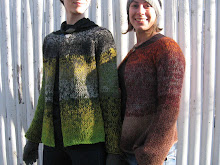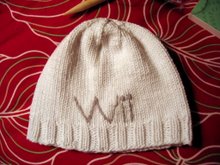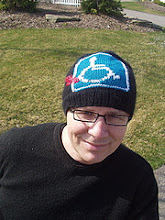
1. I really want to make this sweater in the colors you used. Do you have yarn substitutions if I can't get the Bugga!?
First, there's going to be a big Bugga! update soon, which will include a lot of orange. Sanguine Gryphon is going to let me know when the update is ready to go, and I'll be posting here right away! So stay tuned!
Second, there are two fingering weight yarns that immediately comes to mind as orange sub yarns. First, Madelinetosh Tosh Sock in Citrus is very close. Tangelo is also good, and Glazed Pecan is a nice, more subtle option. Alchemy Juniper is a super-saturated fingering weight yarn, and Tangerine is a perfect orange. Please let me know if any of you have more suggestions!
2. I really want to make this sweater, but not in the color you used. Do you have yarns to suggest?
Obviously I strongly support the yarns I mention above. Here are some more great ideas: Louet Gems fingering, Malabrigo Sock (it's plied so it wears better than other Malabrigo yarns), Sundara Yarn Fingering Silky Merino or Sock (whoa), or... support a local indie dyer! Again, if you have specific suggestions or are having success with a yarn I haven't mentioned, let me know!
3. I am afraid of steeking this thing.
You can do it! This is the very first thing I ever steeked. I followed the knitty tutorial by Wendy and it went perfectly. However, SEW YOUR STEEKS. DO NOT CROCHET THEM. How do I know this? I tried to crochet them and there was an, um, emergency. However, I was able to sew them and the emergency was averted. SEW THEM. Unless you're using a really clingy Shetland-type yarn.
3a. But will they really hold in a superwash yarn?
Yes, if you sew them. Do it with a machine and use small stitches. Sew two reinforcing seams if you're worried. And then don't machine wash the sweater, please.
4. I'd like to make my cardigan with long sleeves. Advice?
This should be an easy modification. The sleeves are fitted at the lower arms, so I think you could leave the cast on numbers as they are without worrying about flares. They'll be straight and rather fitted to the elbow. You can work the sleeve hem facings as written, no problem.
To determine the best length for the sleeve, I would measure your arm from the point at which you want the sleeve to end to your underarm. Then take a look at the Oranje schematic, and see how long the sleeve is, as written, for your size. Just add the difference between the two measurements to the beginning of your sleeve, before any shaping. Does this make sense?
5. Can I make this as a pullover?
Certainly! Just omit the steek stitches from the front. Easy as can be. However, you'll want to read on to question 6...
6. How can I create a more open neckline?
You'll have to do this if you choose to make this a pullover, because there's no way that collar (which is meant to be worn with a few buttons open to reveal the striped collar lining) is going over your head, no matter how small your head might be.
You can stop knitting after you finish Chart B (and the following decrease round) for a wide round neck, stop after Chart C for a smaller round neck, or make a larger, funnel-type neck by manipulating your stitch counts to match the charts. Because the stranded motifs are small, it would be relatively easy to change your decrease rates and maintain a stitch count that will work with the patterns.
7. You're wearing a hat in the knitty pictures. What's up?
Yeah, I had a terrible non-haircut. You can make yourself the hat, though! It's The Opie Hat, one of my free patterns! Make one to match your cardigan! It's very sporty, I think.
download now for free!
8. I have some fingering-weight yarns in my stash that I'd like to use for the two contrasting colors in the yoke. Exactly how much of each color will I need?
Ah ha! I knew I kept the piece of scrap paper with these calculations on it for a reason. Here we go. You'll need VERY close to the same amount of both contrasting colors, so I'll list the amount you need of EACH here:
32 inch: 200 yards of each
36 inch: 230 yards of each
40 inch: 260 yards of each
44 inch: 300 yards of each
48 inch: 320 yards of each
52 inch: 370 yards of each
56 inch: 395 yards of each
9. Seeing that this cardigan is knit at a rather loose gauge for fingering weight, how do you think it would turn out in a heavier-weight yarn?
If you've swatched fingering (sock) weight yarn on US #6 needles, you'll see that the fabric it creates is thin and stretchy, but not holey. However, if you get gauge using sport or DK weight yarn, I think that would create a very nice fabric for this sweater; thicker and warmer than fingering weight would. However, I would recommend sizing up to allow yourself some ease. As it is, the sweater is designed to fit with no ease, which works well when the fabric is stretchy, but might not be so great if the fabric is thicker. If I were to make this cardigan in a sport weight yarn I would make myself the size 36 bust, even though I'm a 32 inch bust, because I'd want to have that ease built in.
You could even use worsted weight yarn, but you'll have to do some calculations to account for the larger gauge. You could make a swatch and figure out your stitches and rows per inch in your desired yarn and then knit the size from the pattern that matches the numbers you're getting (this would be my first choice... just figure out how many stitches you'll need to cast on using your yarn, then go with the pattern numbers that are the closest to the number you get. This will save you having to recalculate everything). You'll have plenty of time to figure out your row gauge and how that will affect your yoke while you're knitting the body. If you find that your yoke is going to be a LOT deeper due to row gauge, you could eliminate some rows from the pattern or eliminate some of the plain MC yoke rounds before the charts begin.
10. The knitty tutorial on steeking recommends that you sew the steeks from the top of the garment to the bottom of the garment. Can I sew them from the bottom to the top?
Yes, no problem!
11. Can this cardigan be worked flat to avoid the steeks entirely?
Certainly. If you feel comfortable working stranded knitting flat, you won't have any problems. For the braids you will have to alternate a knit row and a purl row for the actual braid twisting rows (both are worked as purl rows when working in the round). I've never done this before, but a little bit of experimentation should make it clear).
12. It looks like you've done some crochet edging on the steek edges that are turned to the inside of the body. How did you do that?
To make my steek edges neater, I worked a row of single crochet along the inside steek borders (in the undyed color). I've seen versions that used machine-sewn edgings and grosgrain ribbon edgings, which are also nice. Let me rephrase. The grosgrain ribbon facings are super nice. I've been meaning to do this on my Oranje, but as of January 2012 I'm still wearing it too often to find the time.
Whew! Have more questions? Suggestions? Let me know!

















